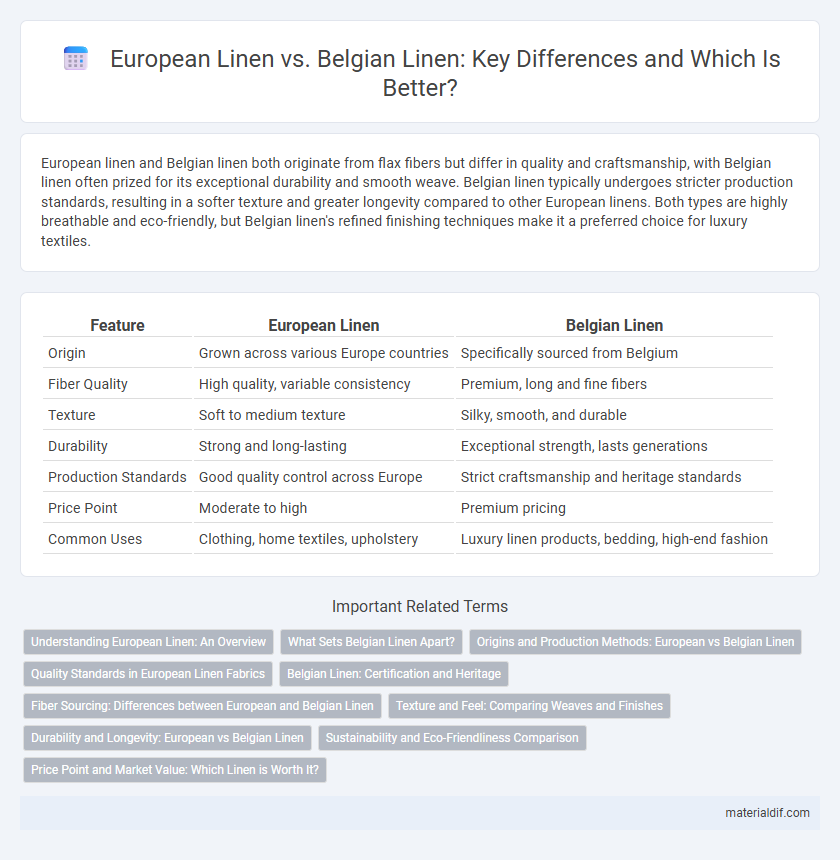European linen and Belgian linen both originate from flax fibers but differ in quality and craftsmanship, with Belgian linen often prized for its exceptional durability and smooth weave. Belgian linen typically undergoes stricter production standards, resulting in a softer texture and greater longevity compared to other European linens. Both types are highly breathable and eco-friendly, but Belgian linen's refined finishing techniques make it a preferred choice for luxury textiles.
Table of Comparison
| Feature | European Linen | Belgian Linen |
|---|---|---|
| Origin | Grown across various Europe countries | Specifically sourced from Belgium |
| Fiber Quality | High quality, variable consistency | Premium, long and fine fibers |
| Texture | Soft to medium texture | Silky, smooth, and durable |
| Durability | Strong and long-lasting | Exceptional strength, lasts generations |
| Production Standards | Good quality control across Europe | Strict craftsmanship and heritage standards |
| Price Point | Moderate to high | Premium pricing |
| Common Uses | Clothing, home textiles, upholstery | Luxury linen products, bedding, high-end fashion |
Understanding European Linen: An Overview
European linen, primarily produced in France, Belgium, and the Netherlands, is renowned for its superior fiber quality and durability. Belgian linen specifically refers to flax fibers grown and woven in Belgium, known for its impeccable texture and sustainability due to ideal growing conditions and traditional craftsmanship. Both types offer exceptional breathability and strength, making them highly valued in luxury textiles and fashion industries.
What Sets Belgian Linen Apart?
Belgian linen is renowned for its exceptional quality due to the region's optimal climate and soil conditions that produce longer flax fibers, resulting in stronger and smoother fabric compared to general European linen. The meticulous harvesting and traditional retting processes in Belgium enhance the fiber's purity and durability, making Belgian linen highly sought after in luxury textiles. Its consistent texture and superior absorbency set Belgian linen apart as a premium choice for fine bedding, apparel, and home decor.
Origins and Production Methods: European vs Belgian Linen
European linen encompasses a broader range of fibers primarily sourced from France, Ireland, and the Netherlands, with cultivation methods emphasizing organic and sustainable practices. Belgian linen, renowned for its premium quality, is cultivated in the Flanders region where the unique climate and traditional retting techniques produce finer, stronger fibers. The distinct production process in Belgium often involves water retting and precise handcrafting, resulting in exceptional durability and a luxurious texture compared to general European linen.
Quality Standards in European Linen Fabrics
European Linen, particularly from the Flax-growing regions of France and Belgium, is renowned for its superior quality standards due to stringent cultivation and harvesting processes. Belgian Linen, certified under the Belgian Linen label, adheres to the highest European quality standards, guaranteeing exceptional durability, fine fiber strength, and a smooth, consistent weave. Both European and Belgian Linen demonstrate premium craftsmanship, but Belgian Linen's rigorous certification ensures reliability and excellence in fabric performance.
Belgian Linen: Certification and Heritage
Belgian Linen stands out for its strict adherence to the Masters of Linen certification, ensuring top-quality flax fibers grown and processed in Europe. This certification guarantees traceability and sustainability, linking Belgian Linen to centuries-old weaving traditions that emphasize durability and finesse. The rich heritage combined with rigorous standards makes Belgian Linen a benchmark for premium linen fabrics globally.
Fiber Sourcing: Differences between European and Belgian Linen
European Linen and Belgian Linen primarily differ in fiber sourcing, with European Linen encompassing fibers from multiple countries including France, Ireland, and the Netherlands, while Belgian Linen specifically uses flax fibers grown exclusively in Belgium. Belgian flax is renowned for its long staple fibers, contributing to higher strength, durability, and a finer weave in the resulting linen fabric. The regional climate and soil quality in Belgium produce flax with superior fiber length and uniformity, distinguishing Belgian Linen within the European linen market.
Texture and Feel: Comparing Weaves and Finishes
European linen often features a coarser texture with a natural, rustic feel due to traditional weaving methods, while Belgian linen is renowned for its exceptionally fine, smooth finish achieved through high-quality flax fibers and meticulous craftsmanship. The weave of Belgian linen typically presents a tighter, more uniform construction that enhances softness and durability, making it ideal for luxury bedding and apparel. In contrast, European linen varieties offer a varied texture spectrum, appealing to those seeking authentic character and breathable fabric with a slightly textured hand.
Durability and Longevity: European vs Belgian Linen
European linen and Belgian linen are both renowned for their exceptional durability and longevity, with Belgian linen often praised for its slightly higher fiber quality due to ideal growing conditions in Belgium's climate. The tightly woven fibers in Belgian linen provide superior strength, resulting in long-lasting fabric that withstands frequent use and multiple washes without significant wear. European linen, while also durable, may vary more in quality depending on the specific region, but both types offer exceptional longevity compared to other natural fibers.
Sustainability and Eco-Friendliness Comparison
European Linen, primarily sourced from France, Belgium, and the Netherlands, is renowned for its sustainable cultivation practices, including low water usage and minimal pesticide application. Belgian Linen, a subset of European Linen, often emphasizes eco-friendliness through strict adherence to environmentally responsible manufacturing processes and certification standards such as OEKO-TEX and Global Organic Textile Standard (GOTS). Both types prioritize durability and biodegradability, but Belgian Linen typically undergoes more rigorous quality controls to ensure higher sustainability benchmarks.
Price Point and Market Value: Which Linen is Worth It?
European linen and Belgian linen both offer excellent quality, but Belgian linen often commands a higher price point due to its meticulous craftsmanship and stricter quality controls. Market value for Belgian linen remains strong among luxury consumers who prioritize durability and fine texture, while European linen provides a more affordable option without significant compromise in quality. Choosing between the two depends on budget constraints and the desired balance between cost and long-term fabric performance.
European Linen vs Belgian Linen Infographic

 materialdif.com
materialdif.com